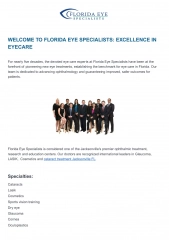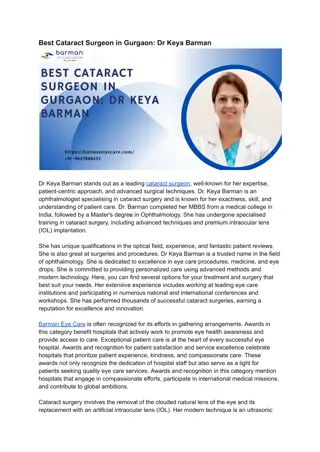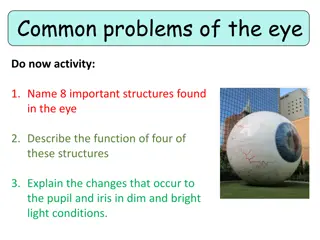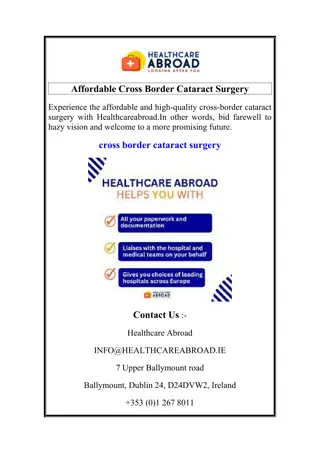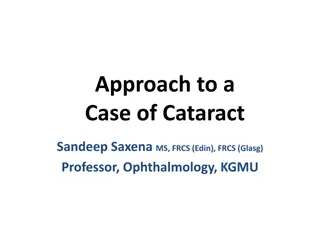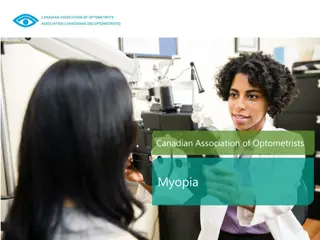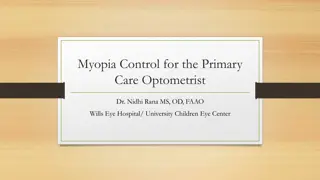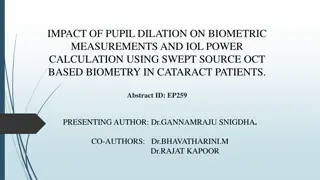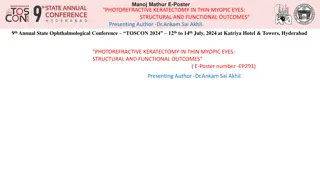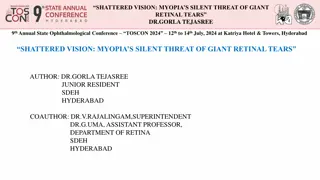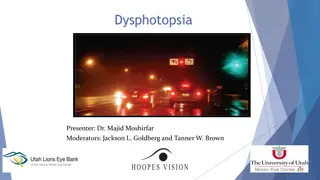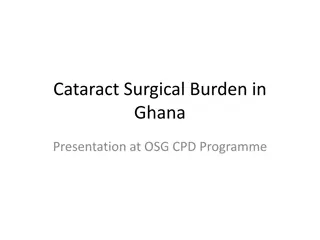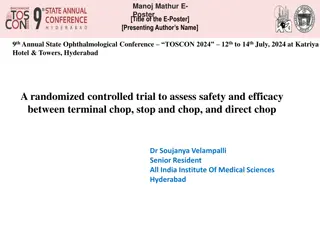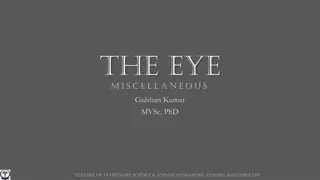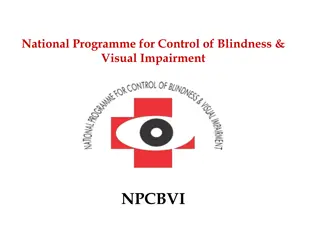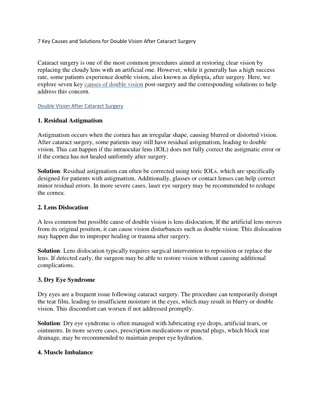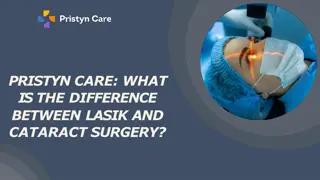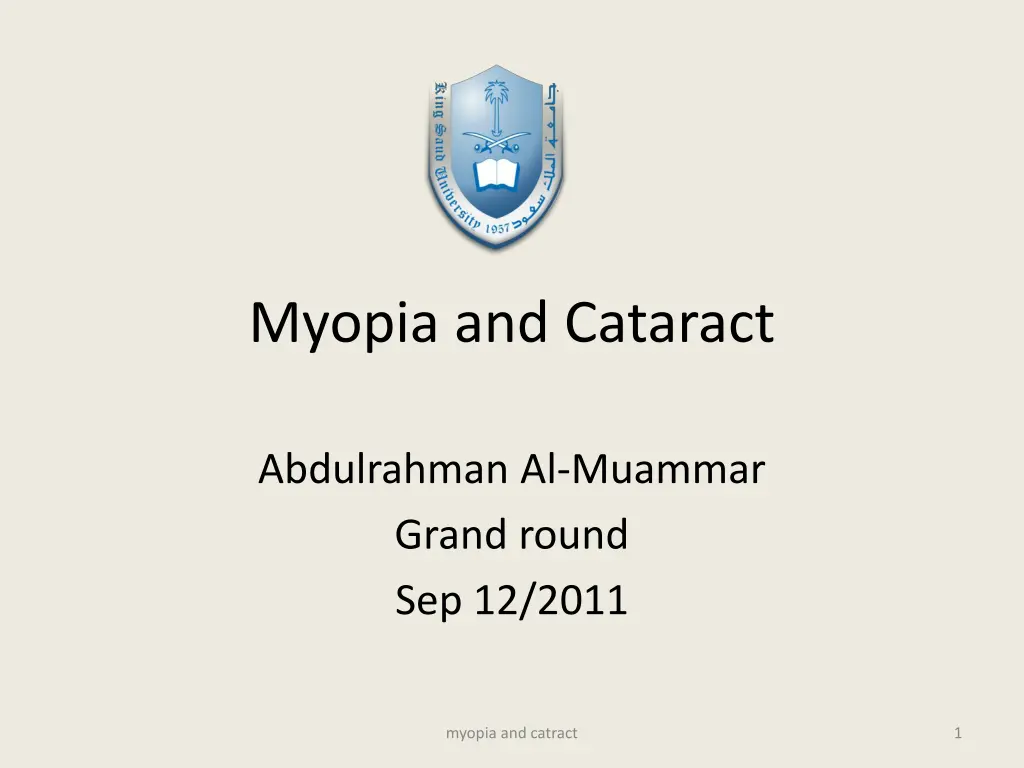
Understanding Myopia and Cataract: Prevalence, Risk Factors, and Consequences
Explore the rising prevalence of myopia globally, its association with cataract, clinical implications, and societal impacts. Learn about the diverse risk factors contributing to myopia, from genetics to environmental influences, and the potential sight-threatening repercussions of uncorrected myopia.
Download Presentation

Please find below an Image/Link to download the presentation.
The content on the website is provided AS IS for your information and personal use only. It may not be sold, licensed, or shared on other websites without obtaining consent from the author. If you encounter any issues during the download, it is possible that the publisher has removed the file from their server.
You are allowed to download the files provided on this website for personal or commercial use, subject to the condition that they are used lawfully. All files are the property of their respective owners.
The content on the website is provided AS IS for your information and personal use only. It may not be sold, licensed, or shared on other websites without obtaining consent from the author.
E N D
Presentation Transcript
Myopia and Cataract Abdulrahman Al-Muammar Grand round Sep 12/2011 myopia and catract 1
Outline Prevalence of myopia Association between cataract and myopia Clinical characteristics and outcomes of cataract surgery in high myopic patients High myopia as a risk factor for retinal detachment after cataract extraction myopia and catract 2
Myopia Myopia can be Axial Non-syndromic Congenital School Adult Syndromic Refractive Cataract Corneal myopia and catract 3
Prevalence of myopia Multiple studies have found an increase in the prevalence of myopia In USA: between 1971-1971 and 1999-2004. Significant increase from 24% to 41.6% in rates of myopia in both men and women cohorts between the ages of 12 and 54 Vitale et al. Arch Ophthalmol 2009 In Israel: between 1990 and 2002. Significant increase from 20.03% to 28.3% in 16 to 22-year age group Dayan et al. Invest Ophthalmol Vis Sci 2005 60% to 80% in the East Saw SM. Clin Exp Optom 2003 myopia and catract 4
Prevalence of myopia www.rightdiagnosis.com/m/myopia/stats/country In USA , 1 in 3 or 25.74% or 70 millions An attempt to extrapolate the above prevalence rate for myopia to the populations of various countries and regions Saudi Arabia: 6,638,660 in 25,795,938 myopia and catract 5
Consequences of myopia It is not only a refractive error that requires optical correction Myopia is an important public health problem because of its frequency and the social, education, and economic consequences In USA, the cost of correcting refractive errors with spectacles or contact lenses is estimated to be 2 billion dollars per year It is an ocular state that is associated with an increased risk of sight threatening conditions, such as cataract, myopic macular degeneration, retinal detachment, macular hole, choroidal neovascular membrane, and glaucoma myopia and catract 6
Risk factors for myopia Causes of myopia are unclear and multifactorial Genetic Ethnicity Gender Environmental Near work Years of education Intelligence score Premature and low birth weight Unconvincing evidence Urbanization Height Personality traits Socioeconomic status Ambient lighting Malnutrition myopia and catract 7
A A Near A A Near A A Distant myopia and catract 8
A A A A myopia and catract 9
Risk factors for myopia Causes of myopia are unclear and multifactorial Genetic Ethnicity Gender Environmental Near work Years of education Intelligence score Premature and low birth weight Unconvincing evidence Urbanization Height Personality traits Socioeconomic status Ambient lighting Malnutrition myopia and catract 10
Preventive measures in myopia Eliminating near work Refractive Bifocal spectacles Pharmacological Atropine Pirenzepine Overnight hard contact lenses Outdoor activity Intraocular pressure reduction myopia and catract 11
Association between myopia and cataract Many studies have suggested that increase in the axial length of the eye is associated with a lower mean age at the time of cataract surgery Myopia is a risk factor for cataract OR Myopic patients are less tolerant to cataract Praveen et al. Eye 2010. reported that high myopia was a powerful risk factor for the development of cataracts in young patient myopia and catract 12
Pathogenesis of myopic cataract Role of lipid peroxidation in the pathogenesis of myopic cataract Oxidative damage of proteins in the lens is widely accepted as a major factor leading to cataract formation Oxidative damage occurs earlier in diabetic and myopic patients Retina is rich with polyunsaturated fatty acids and subjected to photic oxidative injury, especially under conditions such as diabetes and myopia associated with chronic hyopxia High concentration of malondiadlehyde (MDA) which is a lipid peroxidative product was seen in the vitreous and lens of diabetic and myopic patients with cataract Ferrari et al. British Journal of Ophthalmology 1996 Boscia et al. Invest Ophthalmol Vis Sci 2000 Simonelli et al. Exp Eye Res 1989 myopia and catract 13
GSH MDA GSSG myopia and catract 14
Pathogenesis of myopic cataract Importance of vitreous liquefaction in cataract formation Vitrectomy replaces the gel vitreous with liquid and increases the risk for cataract High myopia is associated with increased liquefaction of the vitreous body and has been identified as a risk factor for cataract Stickler syndrome is associated with early cataract myopia and catract 15
Pathogenesis of myopic cataract Importance of vitreous liquefaction in cataract formation Conclusion Vitreous liquefaction is associated with nuclear cataract but it is age dependent Possible mechanisms: Decrease diffusion of growth factors, ions, and metabolites because of decrease pressure gradient between vitreous and lens Exposure of the lens to elevated level of oxygen Increased oxidative stress in the eye may contribute to vitreous liquefaction and formation of nuclear cataract Harcopos et al. Invest Ophthalmol Vis Sci 2005 Barbazetto et al. Exp Eye Res 2004 myopia and catract 16
Clinical Characteristics and Outcomes of Cataract Surgery in Highly Myopic Eyes Purpose To evaluate the clinical characteristic and outcomes of cataract surgery in highly myopic eyes To investigate the role of high axial length as a risk factor for RD after cataract surgery myopia and catract 17
Clinical Characteristics and Outcomes of Cataract Surgery in Highly Myopic Eyes Patients and methods Retrospective comparative case-control study A stratified systemic sample of cataract patients who underwent cataract surgery during the period between 1998 and 2009 Medical files of selected file number were retrieved and reviewed myopia and catract 18
Data Collected Pre operative data Age Sex Past ocular history Past medical history Medications Previous ocular surgeries Ocular trauma Preoperative uncorrected and best corrected visual acuity Clarity of the cornea Type of cataract Fundus exam Intraocular pressure Axial length myopia and catract 19
Data collected Intraoperative data Date of surgery Type of anesthesia Surgical technique Level of surgeon Occurrence of ruptured posterior capsule Vitreous loss IOL implantation Position of IOL implantation myopia and catract 20
Data collected Postoperative data Non corrected and best corrected visual acuity at last visit Post operative refraction Presence of posterior capsular pacification Rate of Nd:YAG capsulotomy Retinal detachment Mean time to retinal detachment Postoperative follow up time myopia and catract 21
Exclusion criteria Age less than 20 Previous ocular surgery Combined surgery Ocular trauma History of preoperative RD Uveitis Proliferative diabetic retinopathy PRP done pre or post cataract surgery Retinal diseases which predispose to RD such as stickler s syndrome and Marfan syndrome Less than 1 year follow up myopia and catract 22
Definition of myopia Myopia can be defined by refractive or axial length Using refractive myopia, it is difficult to differentiate between cause and effect Most of the recent studies have used axial length as a definition for myopia Eyes with an axial length of 25.00 mm have been considered as having high myopia by large number of studies myopia and catract 23
Results Total withdrawn sample size was 2720 Number of eyes with high myopia ( 25.00 mm) that met the inclusion criteria was 352 eyes of 283 patients 500 eyes of 438 patients with axial length between 22.00 mm and 24.00 mm were selected to serve as controls myopia and catract 24
Results Mean follow up duration was 45.1 (27.9) months ranging from 12 to 144 months Follow up time: Cases: Mean (SD), [min max]: 46.2 (33.2), [1 12 Yrs] Controls: Mean (SD), [min max]: 47.5 (31.1), [1 12 Yrs] myopia and catract 25
Age and cataract Variable Cases Controls P value No. (%) No. (%) Age Mean ( SD) 59.5 (11.3) 62.3 (10.7) < 0.0001 Range (20 85) (20 90) The mean age of the case group was younger than that of control group It is consistent with previous studies myopia and catract 26
Distribution of cases and controls by type of cataract Nuclear cataract was strongly associated with high axial myopia Praveen Am J Ophthalmol 2008 Jeon Korean J Ophthalmol 2011 Blue Mountains Eye Study. Invest Ophthalmol Vis Sci 1999 Beaver Dam Eye Study. Invest Ophthalmol Vis Sci 2001 The association between PSC and high myopia was controversial Blue Mountains Eye Study and Jeon et al, found PSC to be more common among high myopic eyes while Praveen et al and other studies found PSC to be more common among emmetropic eyes myopia and catract 27
Distribution of cases and controls by type of surgery myopia and catract 28
PCO and rate of YAG capsulotomy among cases and controls High myopic eyes might be less tolerant to PCO or the nature of PCO might be denser among high myopic eyes. Published rate of YAG capsulotomy in high myopic eyes is 20% to 50% myopia and catract 29
Intraoperative complications among cases and controls Type of Surgery Cases No. (%) Controls No. (%) P value Post. Cap. Rupture 14 (3.9) 5 (1.0) 0.0606 Vitreous loss 8(2.2) 3(0.6) Published data reported that intraoperative vitreous loss occurred in 1% to 2% of high myopic cases myopia and catract 30
Distribution of cases and controls by surgical indices myopia and catract 31
Distribution of cases and controls by surgical indices Cases Control P Value NO.(%) NO.(%) IOL Inseration Anterior 8(2.3) 3(0.6) 0.002 Posterior 302(85) 470(94) Sulcus 18(5.1) 28(5.6) Aphakia 7(1.9) 2(0.4) Suegeon level Consultant 249(70.7) 312(62.4) 0.0115 Resident 103(29.3) 188(37.6) Anaesthesia Local 325(92.3) 479(95.8) 0.0305 General 27(7.7) 21(4.2) myopia and catract 32
Clinical indices outcomes myopia and catract 33
Retinal detachment and cataract surgery The incidence of retinal detachment either after extra- capsular cataract extraction by nuclear expression (ECCE) or phaco-emulsification has been estimated to be within the range of 0.6% to 2.7% Potential risk factors for retinal detachment after cataract extraction include Male sex Younger age Ruptured posterior capsule/vitreous loss Presence of atrophic retinal lesion Retinal detachment in the other eye Nd:YAG laser capsulotomy High axial myopia myopia and catract 34
Risk of RD in high myopic eyes after cataract surgery The relationship between high axial myopia and retinal detachment after cataract extraction has been assessed and reported in many retrospective studies There is a considerable number of studies reported that high axial myopia increases the risk of retinal detachment after cataract extraction while many other studies have not found such increase The reported incidence varies between 0% to 8% myopia and catract 35
Risk of RD in high myopic eyes after cataract surgery The main difficulties in comparing different studies come from Various definition used for high myopia Variation in the follow up period Different surgical technique Hospital setting Ethnicity Inclusion and exclusion criteria myopia and catract 36
Incidence of RD RD across the whole group is 16/852 = 1.9% RD among cases: 14/352 (4%) RD among controls: 2/500 (0.4%) myopia and catract 37
Kaplan-Maier analysis for the risk of RD The cumulative risk of onset of RD: 2% at 12 months 3.5% at 24 months 4.4% at 48 months 5.2% at 54 months myopia and catract 38
Survivorship Function over follow up time RD Incidence Probability RD Event Follow Up time (M) Probability Survive No. (%) 0 - 12 7 (50%) 98% 2% 13 24 4 (28.6%) 96.6% 3.5% 25 36 2 (14.3%) 95.7% 4.4% 37 53 0 (0%) 95.7% 4.4% 54 + 1 (7.1%) 94.9% 5.2% myopia and catract 39
Phacoemulsification versus ECCE Incidence of RD 6 (3.7) 6 (3.5) 2 (11.1) Unadjusted OR 0.31 0.29 - Adjusted OR 0.44 0.37 Risk Factor total P value P value Type of Surgery ECCE Phaco Others 0.184 0.169 0.445 0.323 Phacoemulsification was reported to carry either similar or even lower risk than ECCE( Erie JC 2006, Nielsen NE 1993, Tielsch JM 1996, Russel M 2006, Tuft SJ 2006, Sharma MC 2003). Javitt et al found pseudophakic RD to be higher after phacoemulsification in years soon after its introduction (Javitt JC 1992) myopia and catract 40
Nd:YAG capsulotomy and retinal detachment Unadjusted OR Incidence of RD Adjusted OR Risk Factor total P value P value Yag Capsulatomy 1.1 Yes 1 (4.3) 0.999 1.13 0.912 No 13 (4) Laser capsulotomy was reported to increase the risk of RD 4 fold However, it is difficult to come to conclusion from different studies regarding the risk of RD following Nd:YAG capsulotomy as using different energy might influence the changes occurring in the vitreous that may predispose to RD. myopia and catract 41
Ruptured posterior capsule+/- Vitreous loss Tielsch et al 1995, reported that intraoperative posterior capsular rupture increases the risk for retinal detachment fivefold myopia and catract 42
Age and RD among high myopic eyes Incidence of RD No. (%) Unadjusted OR Adjusted OR Risk Factor total P value P value Age < 50 50* 4 (7.1) 10 (3.4) 2.2 0.252 1.72 0.450 A trend was found indicating association between age at surgery of younger than 50 years and an increased risk of RD myopia and catract 43
Gender and RD among high myopic eyes Male gender was found by several studies to be a high risk for RD following cataract extraction (Davidson 1988, Boberg 2003 JCRS, Olsen 2000, Erie 2006, Rowe 1995, Sheu 2010) Unadjusted OR Incidence of RD Adjusted OR Risk Factor Total P value P value Sex 2.9 Male 11 (5.5) 0.106 6.8 0.891 Female* 3 (2) myopia and catract 44
Conclusion Cataract surgery in high myopic eyes has excellent visual outcome but less than emmetropic eyes High myopic patients tend to have cataract surgery at younger age The incidence of intraoperative ruptured posterior capsule and postoperative YAG capsulotomy was higher in high myopic eyes myopia and catract 45
Conclusion Incidence of retinal detachment after cataract surgery is higher among high myopic eyes than emmetropic eyes Among high myopic eyes, being male, age <50, and ruptured posterior capsule with vitreous loss increases the risk of RD 5 years cumulative risk for RD is 5.2% myopia and catract 46
Conclusion Given the low incidence of postoperative RD, large number of cases are required for accurate analysis Our findings will be helpful in estimating the risks and benefits of cataract surgery in high myopic eye We would emphasize the importance of regular fundus examination after cataract surgery for high myopic eyes myopia and catract 47
Acknowledgment Dr. Ahmed Mousa Dr. Dora Alharkan Dr. Sultan Alreshidi Dr. Tariq Almudhaiyan Dr. Mohammed Alotaibi Ms. Sara Alsuleiman myopia and catract 48

